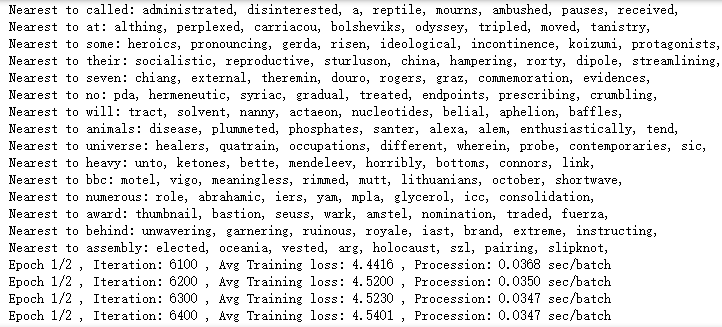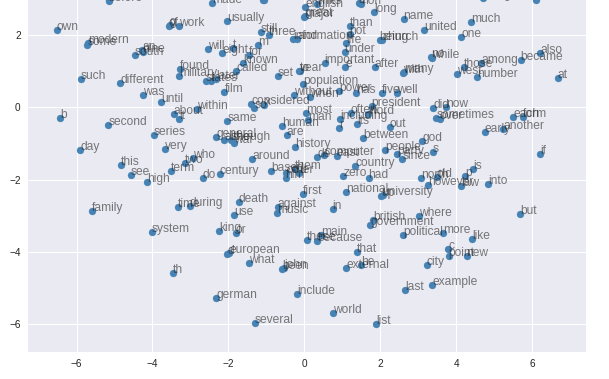from google.colab import drive drive.mount('/content/gdrive')

!mkdir '/content/gdrive/My Drive/dataset'
path = '/content/gdrive/My Drive/dataset/text8' with open(path) as ft_: full_text = ft_.read()
def text_processing(ft8_text): ''' 替换掉标点符号 ''' ft8_text = ft8_text.lower() ft8_text = ft8_text.replace('.', '<period>') ft8_text = ft8_text.replace(',', '<comma>') ft8_text = ft8_text.replace('"', '<quotation>') ft8_text = ft8_text.replace(';', '<semicolon>') ft8_text = ft8_text.replace('!', '<exclamation>') ft8_text = ft8_text.replace('?', '<question>') ft8_text = ft8_text.replace('(', '<paren_l>') ft8_text = ft8_text.replace(')', '<paren_r>') ft8_text = ft8_text.replace('--', '<hyphen>') ft8_text = ft8_text.replace(':', '<colon>') ft8_text_tokens = ft8_text.split() return ft8_text_tokens ft_tokens = text_processing(full_text)
import random import collections import math import time import re import numpy as np word_cnt = collections.Counter(ft_tokens) shortlisted_words = [w for w in ft_tokens if word_cnt[w] > 7] print(shortlisted_words[:15])

def dict_creation(shortlisted_words): ''' 建立起单词和它出现频率之间的对应关系 ''' counts = collections.Counter(shortlisted_words) ''' #将单词按出现次数由高到低排序,例如"the"出现最多就排第一位,它的序号为0,“an”次数第二多,序号 对应为1,单词序号很重要,后面会用来建立单词的one-hot-vector,也就是把单词序号下标在向量中设置为1 ''' vocabulary = sorted(counts, key=counts.get, reverse=True) #将单词序号映射到单词 rev_dictionary_ = {ii:word for ii, word in enumerate(vocabulary)} #将单词映射到序号, dictionary_ = {word: ii for ii, word in rev_dictionary_.items()} return dictionary_, rev_dictionary_ dictionary_, rev_dictionary_ = dict_creation(shortlisted_words) words_cnt = [dictionary_[word] for word in shortlisted_words]
''' 根据负采样公式,把频率过低的单词过滤掉 ''' thresh = 0.00005 ''' 建立单词序号与它出现次数的映射关系 ''' word_counts = collections.Counter(words_cnt) total_count = len(words_cnt) #建立单词与出现频率的对应关系 freqs = {word: count / total_count for word, count in word_counts.items()} #根据负采样公式过滤单词 p_drop = { word: 1 - np.sqrt(thresh / freqs[word]) for word in word_counts} train_words = [word for word in words_cnt if p_drop[word] < random.random()]
def skipG_target_set_generation(batch_, batch_index, word_window): ''' 根据表12-1的方式构造网络训练数据 ''' random_num = np.random.randint(1, word_window + 1) #选择中心词左边窗口范围内的单词 words_start = batch_index - random_num if (batch_index - random_num) > 0 else 0 #选择中心词右边窗口范围内单词 words_stop = batch_index + random_num window_target = set(batch_[words_start:batch_index] + batch_[batch_index+1 : words_stop+1]) return list(window_target) def skipG_batch_creation(short_words, batch_length, word_window): #将训练单词分批 batch_cnt = len(short_words) // batch_length short_words = short_words[:batch_cnt * batch_length] for word_index in range(0, len(short_words), batch_length): #input_words是中心词 #label_words 是中心词左右两边窗口范围内的单词 input_words, label_words = [], [] word_batch = short_words[word_index: word_index + batch_length] for index_ in range(len(word_batch)): batch_input = word_batch[index_] batch_label = skipG_target_set_generation(word_batch, index_, word_window) label_words.extend(batch_label) input_words.extend([batch_input] * len(batch_label)) ''' 给定句子 ’the cat jump over the dog',窗口范围2,如果中心词是jump那么输出格式为 input_words = [jump ,jump ,jump ,jump] label_words = [the, cat, over, the] ''' yield input_words, label_words
import tensorflow as tf tf_graph = tf.Graph() with tf_graph.as_default(): input_ = tf.placeholder(tf.int32, [None], name='input_') label_ = tf.placeholder(tf.int32, [None, None], name='label_') #构建中间二维向量 word_embed = tf.Variable(tf.random_uniform((len(rev_dictionary_), 300), -1, 1)) #计算one-hot-vector与中间向量乘机,其实就是把二维向量指定行选取出来 embedding = tf.nn.embedding_lookup(word_embed, input_) vocabulary_size = len(rev_dictionary_) #添加中间层和输出层之间的链路参数,并使用正太分布对参数进行初始化 sf_weights = tf.Variable(tf.truncated_normal((vocabulary_size, 300), stddev=0.1)) sf_bias = tf.Variable(tf.zeros(vocabulary_size)) ''' 使用梯度下降法训练参数,我们不训练所有参数而是随机选取第三层100个节点对应的链路参数进行修正, 由于每个节点对应300个链路参数,因此总共修正的有(100+1)*300个参数 ''' loss_fn = tf.nn.sampled_softmax_loss(weights=sf_weights, biases=sf_bias, labels=label_, inputs=embedding, num_sampled=100, num_classes=vocabulary_size, ) cost_fn = tf.reduce_mean(loss_fn) optim = tf.train.AdamOptimizer().minimize(cost_fn)
''' 使用余弦公式计算两个单词向量的距离,通过距离的大小展示单词含义是否相近 ''' with tf_graph.as_default(): validation_cnt = 16 validation_dict = 100 #从编号为0到100的单词中随机选出8个 validation_words = np.array(random.sample(range(validation_dict), validation_cnt//2)) #再从编号为1000到1100的单词随机选出8个 validation_words = np.append(validation_words, random.sample(range(1000, 1000+validation_cnt), validation_cnt//2)) validation_data = tf.constant(validation_words, dtype=tf.int32) #先对单词向量做归一化处理 normalization_embed = word_embed / (tf.sqrt(tf.reduce_sum(tf.square(word_embed), 1, keep_dims = True))) #将单词对应的向量挑选出来 validation_embed = tf.nn.embedding_lookup(normalization_embed, validation_data) #计算两个向量内积,所得结果就是向量间距离 word_similarity = tf.matmul(validation_embed, tf.transpose(normalization_embed))
#循环训练10次,由于训练过程非常耗时,如果没有GPU,在训练时可以尝试把该值变小 epochs = 2 batch_length = 1000 word_window = 10 with tf_graph.as_default(): saver = tf.train.Saver() with tf.Session(graph = tf_graph) as sess: iteration = 1 loss = 0 sess.run(tf.global_variables_initializer()) for e in range(1, epochs + 1): batches = skipG_batch_creation(train_words, batch_length, word_window) start = time.time() for x, y in batches: train_loss, _ = sess.run([cost_fn, optim], feed_dict={input_: x, label_: np.array(y)[:, None]}) loss += train_loss if iteration % 100 == 0: end = time.time() print("Epoch {}/{}".format(e, epochs), ", Iteration: {}".format(iteration), ", Avg Training loss: {:.4f}".format(loss/100), ", Procession: {:.4f} sec/batch".format((end - start) / 100)) loss = 0 start = time.time() #迭代训练2000次后计算一下单词相似度 if iteration % 2000 == 0: similarity_ = word_similarity.eval() for i in range(validation_cnt): validated_words = rev_dictionary_[validation_words[i]] #根据计算距离,找出与当前单词距离最短的8个词 top_k = 8 nearest = (-similarity_[i, :]).argsort()[1: top_k+1] log = "Nearest to %s:" % validated_words for k in range(top_k): close_word =rev_dictionary_[nearest[k]] log = '%s %s,' % (log, close_word) print(log) iteration += 1 path = '/content/gdrive/My Drive/skipGram_text8.ckpt' save_path = saver.save(sess, path) embed_mat = sess.run(normalization_embed)

import matplotlib.pyplot as plt from sklearn.manifold import TSNE with tf.Session(graph=tf_graph) as sess: path = '/content/gdrive/My Drive/skipGram_text8_epoch10.ckpt' saver = tf.train.import_meta_graph(path + '.meta') #将训练后存储成文件的网络参数重新加载 saver.restore(sess, path) sess.run(tf.global_variables_initializer()) embed_mat = sess.run(word_embed) #选取250个单词向量在二维平面上展示 word_graph = 250 tsne = TSNE() word_embedding = tsne.fit_transform(embed_mat[:word_graph,:]) fig, ax = plt.subplots(figsize=(10, 10)) for idx in range(word_graph): plt.scatter(*word_embedding[idx, :], color='steelblue') plt.annotate(rev_dictionary_[idx], (word_embedding[idx, 0], word_embedding[idx, 1]), alpha=0.6)

